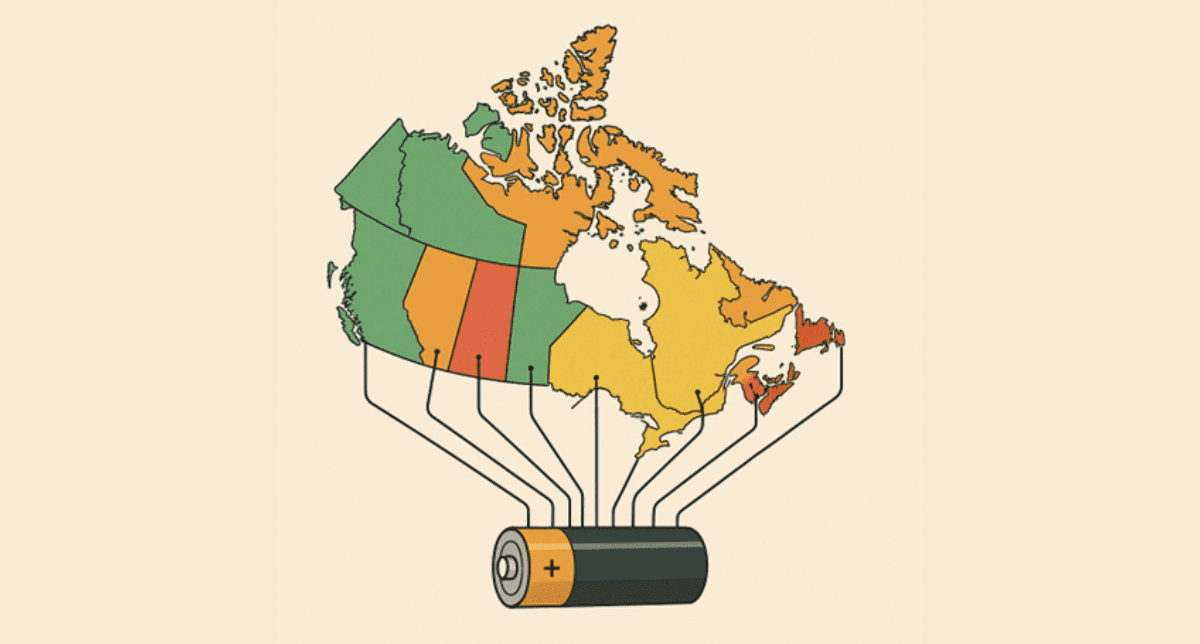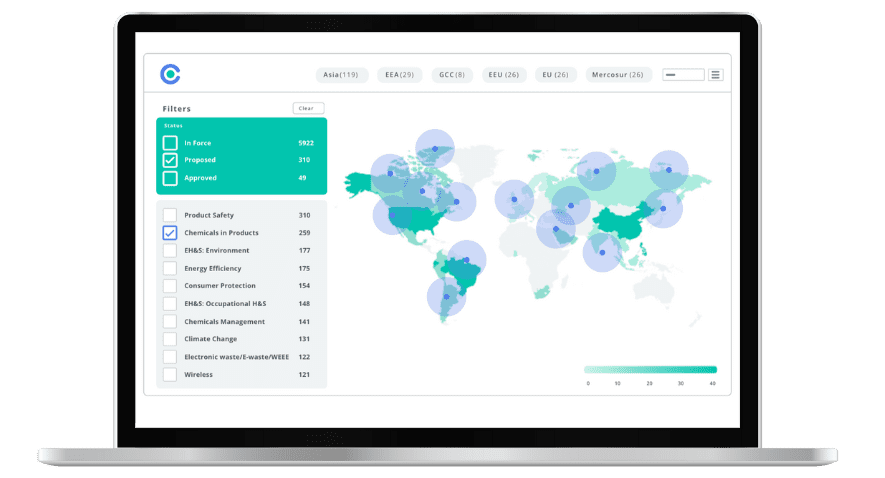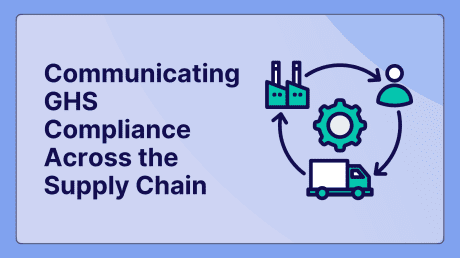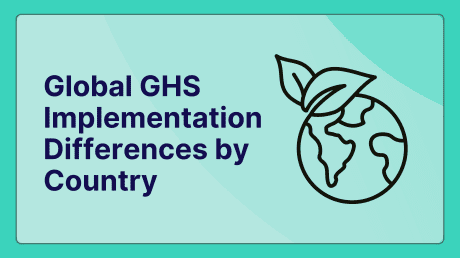
The Current State of EV Battery Recycling in Canada

This blog was originally posted on 2nd July, 2025. Further regulatory developments may have occurred after publication. To keep up-to-date with the latest compliance news, sign up to our newsletter.
AUTHORED BY ANDREW O’NEILL, REGULATORY COMPLIANCE SPECIALIST, COMPLIANCE & RISKS
Canada’s push toward electrification is accelerating, with ambitious targets for electric vehicle (EV) adoption in place. However, a critical question looms: what happens to the batteries once these EVs reach the end of their life? Unlike jurisdictions such as the European Union, Canada lacks a comprehensive national framework for end-of-life EV battery recycling.
This regulatory gap is creating uncertainty for manufacturers, recyclers, and policymakers. In this blog, I explore Canada’s current regulatory landscape for battery recycling, the challenges arising from the absence of a unified approach, and how some provinces are stepping in with their own solutions. I conclude with a “What to Watch” section highlighting emerging developments and anticipated policy moves in this evolving area.
No National Framework for End-of-Life EV Batteries
At the federal level, Canada has no dedicated regulations or extended producer responsibility mandates governing the recycling of EV batteries. The focus to date has been on spurring EV adoption for example, the federal government has mandated 100% zero-emission new car sales by 2035 but no parallel plan exists for dealing with batteries once they are too depleted for vehicle use.
Essentially, once an EV battery reaches end-of-life, there is no clear national policy dictating who is responsible for its collection, safe handling, or recycling. This stands in contrast to places like Europe, where an updated battery regulation (2023) requires manufacturers to organize battery take-back and even meet recycled content quotas for new batteries.
Because of this gap, Canada’s end-of-life EV batteries currently fall under a patchwork of general waste and hazardous goods rules. Transport Canada oversees the safe transport of used lithium batteries, and Environment and Climate Change Canada regulates hazardous materials, but no federal law requires recycling or resource recovery for EV batteries. Policy experts note that North America’s regulatory frameworks for EV battery end-of-life management are essentially non-existent. In fact, a recent study found that no Canadian jurisdiction has a firm recycling mandate in place for EV batteries, not even provinces heavily invested in EV manufacturing.
What are the Challenges for Industry Stakeholders?
The absence of a national strategy creates a range of challenges for industry stakeholders. Recycling companies, automakers, and battery producers are left without clear obligations or incentives to invest in collection and recycling infrastructure. This uncertainty has real economic impacts; the recent bankruptcy of a major Canadian battery recycler has been cited by experts as a warning sign that the market lacks the stability and support that government regulation could provide.
In short, without mandated programs or targets, building a business case for large scale EV battery recycling in Canada is difficult. Experts have described the current environment as something of a regulatory “Wild West,” where few rules and standards exist to guide end-of-life battery management.
Each retired EV battery is essentially handled on a case-by-case basis; some are stored, some are exported, some may be repurposed or recycled by manufacturers voluntarily. However, there are no reporting or tracking requirements to transparently monitor what ultimately happens to these batteries.
This lack of transparency makes it impossible to gauge national recycling rates or ensure that hazardous materials aren’t ending up in landfills. It also means potential valuable materials (lithium, cobalt, nickel) could be lost rather than recovered for reuse. For automakers and importers, the patchwork approach raises compliance questions; Should they be investing in take-back programs now, or wait for future regulations? For recyclers, the risk is investing in capacity that may not be utilized if batteries are stockpiled or shipped elsewhere under no clear rules. The net effect is a hesitancy to invest and innovate in Canada’s battery recycling capabilities, even as the volume of retired batteries is projected to surge in the coming years.
Stakeholders widely agree that a clear regulatory framework whether through federal law or harmonized provincial policies is needed to provide the certainty that will drive investment, ensure environmental protection, and allocate responsibilities fairly across the value chain.
Struggling to stay on top of your compliance obligations? Discover how our Compliance Solutions for the Automotive Industry can help you stay on top of your regulatory challenges!
Provincial Responses: Patchwork Solutions
In the vacuum of federal action, provincial and territorial governments have started to develop their own measures to manage battery waste though these are mostly focused on smaller household batteries and vary significantly by region. This has resulted in a patchwork of regulations and programs, with some provinces forging ahead and others holding back.
Ontario
Ontario introduced a Batteries Regulation in 2020 under its Resource Recovery and Circular Economy Act, establishing an individual producer responsibility program for consumer batteries. This regulation requires battery producers to fund and manage the collection and recycling of batteries sold in Ontario. In early 2025, the province amended its Batteries Regulation to streamline requirements and reduce burdens on producers.
Changes included extending interim recycling targets (maintaining a 45% collection target for 2025) and simplifying reporting by combining single-use and rechargeable battery categories.
These tweaks aim to increase flexibility and participation in the program. Notably, however, Ontario’s framework currently covers household batteries (generally small single-use or rechargeable batteries) large-format EV batteries from vehicles are not explicitly addressed, meaning the fate of an EV’s lithium-ion pack remains outside Ontario’s existing producer responsibility scheme.
Yukon
In Canada’s north, the Yukon Territory is launching a brand new battery recycling program. In January 2024, Yukon approved an Extended Producer Responsibility (EPR) Regulation for hazardous and special products, including batteries.
Under this mandate, producers are responsible for funding the collection and recycling of designated products. Following this, Yukon approved a program plan by Call2Recycle (a national battery stewardship organization) to operate the territory’s first household battery recycling program, slated to begin on July 1, 2025.
This program will accept household batteries (up to 5 kg each) at no charge to consumers, establishing convenient drop-off points in the territory. While focused on smaller batteries, Yukon’s embrace of an EPR model – making producers financially and operationally responsible – is a notable step forward in Canada’s battery recycling landscape.
British Columbia
British Columbia has long been viewed as a leader in recycling policy and had signaled that it would be the first to tackle EV batteries. B.C. already includes many electronics and batteries in its recycling regulations, and it planned to expand EPR to EV batteries in phases, aiming for a full program by 2026.
However, in a recent turn of events, B.C. authorities indicated they are pausing or backing away from implementing an EV battery mandate on that original timeline.
The province may be re-evaluating its approach, possibly due to the complexity of handling large battery systems or waiting for a national alignment. B.C.’s hesitation illustrates the uncertainty provinces face: without federal coordination, even proactive regions must balance ambition with practicality.
Quebec
Quebec has implemented EPR for small household batteries and even launched a voluntary recovery program for EV batteries in 2023. Initial proposals in Quebec would have placed responsibility on automakers for end-of-life EV batteries, but these plans were put on hold after industry pushback.
For now, Quebec relies on voluntary initiatives and general hazardous waste rules for larger batteries. Like B.C., Quebec’s experience underscores that provincial efforts in isolation face challenges, and a broader framework may be needed to bring consistency across Canada.
Overall, these provincial actions demonstrate a recognition of the battery recycling issue, but they remain fragmented. Most current programs deal with small consumer batteries, and no province yet has a fully operational, mandatory recycling program for EV-scale batteries. The disparity between jurisdictions can also be confusing for companies operating Canada-wide. A carmaker selling EVs nationally might face different obligations (or none at all) depending on the province. This patchwork also risks inefficiencies: separate collection and processing systems in each province could prevent Canada from achieving economies of scale in battery recycling.
What to Watch: What’s Next for EV Battery Recycling in Canada?
With the volume of retired EV batteries set to grow exponentially, pressure is mounting for more coherent and comprehensive policies. Industry stakeholders and environmental experts are actively discussing several potential developments that could shape Canada’s battery recycling landscape in the near future:
Extended Producer Responsibility (EPR) for EV Batteries
Expect increasing calls for (and eventual introduction of) an EPR scheme that makes automakers and battery importers responsible for collecting and recycling end-of-life EV batteries. This would mirror frameworks in Europe, where manufacturers must organize battery take-back and recycling programs.
A Canadian EPR program could require companies to set up or fund recycling systems, ensuring that batteries are diverted from landfill and processed safely. Provinces or the federal government may move toward mandating such producer responsibility to close the loop on battery life cycles.
Recycled Content and Circular Economy Mandates
Another trend to watch is the potential for recycled content requirements in new batteries. Policymakers are examining whether to require a certain percentage of critical minerals (lithium, cobalt, etc.) in new EV batteries to come from recycled sources. The European Union’s 2023 battery regulation already moves in this direction, introducing minimum recycled material thresholds for future batteries.
Canadian think tanks and advocacy groups have urged leaders to adopt similar measures not only to create a market demand for recycled materials but also to incentivize investments in domestic recycling capacity.
If Canada enacts recycled-content rules or even standardized battery labeling for recyclability, it would signal a shift toward a more circular battery economy.
Federal Strategy and Coordination
Watch for Ottawa to become more actively involved in EV battery end-of-life policy. There are growing discussions at the federal level about developing a national EV battery recycling strategy. Such a strategy could involve setting nationwide guidelines or targets, coordinating research into recycling technologies, and possibly introducing regulations to harmonize tracking and reporting. Ideas like a “battery passport” (a digital record to track a battery’s composition and life cycle) have been floated as tools to improve transparency and accountability.
Given that the federal government is investing billions to build up Canada’s battery manufacturing and critical minerals sector, there is a clear incentive to also address the recycling stage.
Stakeholders anticipate that federal policymakers will convene industry and provincial partners to outline a cohesive approach whether through new legislation, updates to existing environmental laws, or national standards that provinces can adopt.
In summary, Canada’s current regulatory landscape for battery recycling is in flux. The lack of a comprehensive national framework has led to uncertainty and a patchwork of provincial measures, challenging industry stakeholders and raising concerns about Canada’s readiness for the coming wave of end-of-life EV batteries.
On the positive side, awareness of this gap is growing, and both governments and industry are starting to formulate solutions. Regulatory and compliance professionals should closely watch these emerging trends – from EPR programs to potential federal initiatives – as they will shape the responsibilities and opportunities in the battery recycling sector in the years ahead. By staying informed and proactive, stakeholders can better navigate the changing landscape and contribute to building a robust, sustainable system for managing Canada’s EV batteries from cradle to grave.
The growing trend towards Extended Producer Responsibility is not isolated to EV Battery Recycling. EPR for Waste Electrical and Electronic Equipment (WEEE) places the onus on producers to manage the environmental impacts of their products throughout their entire lifecycle, especially at the end of life. Check out our whitepaper ‘Global Overview of WEEE EPR Obligations‘ for a comprehensive overview of regulatory developments on WEEE EPR frameworks.
Stay Ahead Of Regulatory Changes in EV Battery Recycling in Canada
Want to stay ahead of regulatory developments such as EV Battery Recycling in Canada?
Accelerate your ability to achieve, maintain & expand market access for all products in global markets with C2P – your key to unlocking market access, trusted by more than 300 of the world’s leading brands.
C2P is an enterprise SaaS platform providing everything you need in one place to achieve your business objectives by proving compliance in over 195 countries.
C2P is purpose-built to be tailored to your specific needs with comprehensive capabilities that enable enterprise-wide management of regulations, standards, requirements and evidence.
Add-on packages help accelerate market access through use-case-specific solutions, global regulatory content, a global team of subject matter experts and professional services.
- Accelerate time-to-market for products
- Reduce non-compliance risks that impact your ability to meet business goals and cause reputational damage
- Enable business continuity by digitizing your compliance process and building corporate memory
- Improve efficiency and enable your team to focus on business critical initiatives rather than manual tasks
- Save time with access to Compliance & Risks’ extensive Knowledge Partner network

Chemicals Quarterly – Q2 2025 Regulatory Update
Your Q2 2025 update on key regulatory changes affecting chemicals in products worldwide.







